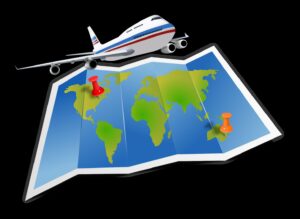6 Tips for Starting Out as a Digital Nomad
5 min readFor remote workers seeking inspiration in new spaces, hopping from country to country with nothing but a laptop bag and a suitcase is the ultimate lifestyle hack. Known as “digital nomads,” these wandering workers often travel full-time while earning money part-time. Sounds pretty great, right? Well, that’s why I became one in 2018.
Burnt out from working long hours in a New York City office and the general dystopian nightmare of corporate America, I decided to quit my job in television, sell all my belongings, and travel the world working as a freelance travel and food writer. Let’s just say my parents were not too thrilled about me losing my healthcare, my 401(k), and a decent paycheck. But the freedom to wake up (sans alarm clock), decide whether to start the day with a swim, a trip to a new café, or a jungle hike leaves no doubt in my mind that becoming a digital nomad was the right move for me.
In the wake of the pandemic, many Americans, especially millennials, realize that working remotely from home results in a better work-life balance. So, why not do the same thing from the shores of Mexico or Sri Lanka or Portugal? While having an American passport is certainly a privilege, it’s also important to respect the local community and customs of the countries you’re visiting. Life as a digital nomad isn’t all laptop shots against an azure ocean; here are some crucial tips for making the transition.
You don’t need as much work equipment as you think
Some nomads may disagree with me on this, but all you really need is a laptop and a charger. If you run your own podcast, sure, you’ll need a nice microphone. If you’re a photographer, obviously, you’ll need all your gear. But as a writer, I’ve never needed anything else for work besides my laptop, and occasionally headphones. If I’m going to a really remote area, Google Fi puts my mind at ease regarding Wi-Fi. So forget a second monitor and ditch the extra mousepad, the laptop stand, and the portable keyboard. Pack light; you won’t regret it.
Don’t expect to spend all day working from the beach
Who doesn’t want turquoise blue waters as their #officeview? Sadly, laptops don’t do too well in the heat, and glare from the sun on your screen will quickly make you realize that you won’t be getting much work done while out in nature.
While a lot of the appeal is ditching the cubicle and working anywhere, you don’t want to get sand into the cracks in your keyboard. You need a calm café with fast Wi-Fi, tasty snacks, and plenty of outlets. Oh, and depending on where you go, don’t forget to pack your converter.
Give yourself a daily routine and try your best to stick to it
This is crucial if you’re a freelancer or you’re running your own business. We’d all love to spend the day roaming the alleyways of a quaint ancient city, but someone’s gotta pay for those plane tickets and Airbnbs (ahem, it’s you).
I’m a night owl, so I wake up late and go straight to the gym. As a food writer eating my way through every city I visit, this is crucial for me. Then, I walk back to my accommodation, shower, and head off to a different café or restaurant for lunch and some work. You’ll find that you can accomplish most of your work in a few highly productive hours, and then you have the afternoon to go exploring. If you have the freedom, work long hours three days per week and plan your adventures for the other four.

You can find coworking spaces in Chiang Mai, Madeira, and beyond.
Photo by Peter Borter/Unsplash
If you’re an extrovert, join a coworking or coliving space
For some digital nomads traveling alone, life can get lonely. That’s where digital nomad communities come in, with Bali, Chiang Mai, Thailand, and most recently, the island of Madeira in Portugal being the most popular. There are numerous coworking spaces like KoHub in Thailand and Punspace in Chiang Mai where remote workers can get a daily, weekly, or monthly pass to come in and use super-fast Wi-Fi and quiet rooms with air-conditioning, plus attend networking events. There are also plenty of databases like Coworking Nomads to search for offices in your nearest city. This is an easy way for people to find like-minded travelers looking to make new friends, go on a bar crawl around town, or even a speed dating night.
If you want to be even more immersed in the digital nomad community of your choice, there are also coliving spaces, like Outpost in Bali and Neighbourgood in South Africa. Some coworking spaces double as coliving spaces, where workers can live there among other digital nomads. This is one of the quickest and easiest ways to meet other remote workers during your travels.
When it comes to wellness, location is everything
One of the most common questions in digital nomad Facebook groups is, “How do you stay healthy while traveling?” During my three years of nonstop travel, the biggest trick I’ve learned is to base yourself near a gym. Depending on the location, that’s easier said than done, especially in places like Japan and Singapore where they are not as plentiful or affordable. Do a Google search of the gyms in your desired area and read the reviews. If you can simply walk down the street to the gym, you’re much more likely to go.
I’ve also found that basing yourself in an affordable location makes wellness more accessible. During the pandemic, I spent a year in Hoi An, Vietnam. While there, I was able to hire a personal trainer and work out with him three times a week for about $25, something that would have cost hundreds of dollars in New York City.
Oh, and whatever you do, don’t forget your travel insurance with companies like Allianz and SafetyWing. Accidents happen, and people get sick. Paying thousands out of pocket is a fast-track toward a one-way ticket home.
Slow travel is the way to go
Japan was the first stop I made as a digital nomad. Within two months, I had visited 19 different cities in Japan. Let’s just say that when I got to my next country, I was exhausted. Packing up your suitcases and boarding planes, trains, or buses multiple times a week is tiring and not conducive to work. It’s also not a sustainable way to travel, leaving a hefty carbon footprint.
I know it’s exciting to visit a new location, but instead, pick one place and stay there for at least two weeks. That way, you can get into a groove with work, see the majority of things you were hoping to see, and develop a different understanding and respect for the local culture and community. The great thing about being a digital nomad is that if you like a place, you can always stay longer.


